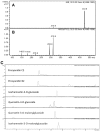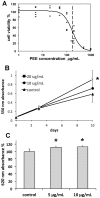Posidonia oceanica (L.) Delile Ethanolic Extract Modulates Cell Activities with Skin Health Applications
- PMID: 29320400
- PMCID: PMC5793069
- DOI: 10.3390/md16010021
Posidonia oceanica (L.) Delile Ethanolic Extract Modulates Cell Activities with Skin Health Applications
Abstract
Seagrasses are high plants sharing adaptive metabolic features with both terrestrial plants and marine algae, resulting in a phytocomplex possibly endowed with interesting biological properties. The aim of this study is to evaluate the in vitro activities on skin cells of an ethanolic extract obtained from the leaves of Posidonia oceanica (L.) Delile, family Potamogetonaceae, herein named Posidonia ethanolic extract (PEE). PEE showed high radical scavenging activity, high phenolic content, and resulted rich in chicoric acid, as determined through HPLC-MS analysis. The use of MTT assay on fibroblasts showed a PEE cytotoxicity threshold (IC05) of 50 µg/mL at 48 h, while a sub-toxic dose of 20 µg/mL induced a significant increase of fibroblast growth rate after 10 days. In addition, an ELISA assay revealed that PEE doses of 5 and 10 µg/mL induced collagen production in fibroblasts. PEE induced dose-dependent mushroom tyrosinase inhibition, up to about 45% inhibition at 1000 µg/mL, while 50% reduction of melanin was observed in melanoma cells exposed to 50 µg/mL PEE. Finally, PEE lipolytic activity was assessed by measuring glycerol release from adipocytes following triglyceride degradation. In conclusion, we have collected new data about the biological activities of the phytocomplex of P. oceanica seagrass on skin cells. Our findings indicate that PEE could be profitably used in the development of products for skin aging, undesired hyperpigmentation, and cellulite.
Keywords: adipocytes; chicoric acid; collagen type I; fibroblasts; lipolysis; melanin; tyrosinase.
Conflict of interest statement
The authors declare no conflict of interest. The founding sponsors provided financial support to the study and made available plant material.
Figures




References
-
- Papenbrock J. Highlights in seagrasses’ phylogeny, physiology, and metabolism: What makes them special? ISRN Bot. 2012;2012:103892. doi: 10.5402/2012/103892. - DOI
-
- Vacchi M., De Falco G., Simeone S., Montefalcone M., Morri C., Ferrari M., Bianchi C.N. Biogeomorphology of the Mediterranean Posidonia oceanica seagrass meadows. Earth Surf. Process. Landf. 2017;42:42–54. doi: 10.1002/esp.3932. - DOI
-
- Dumay O., Costa J., Desjobert J.M., Pergent G. Variations in the concentration of phenolic compounds in the seagrass Posidonia oceanica under conditions of competition. Phytochemistry. 2004;65:3211–3220. - PubMed
MeSH terms
Substances
LinkOut - more resources
Full Text Sources
Other Literature Sources

